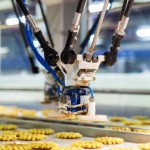Mobile robots boost productivity and safety
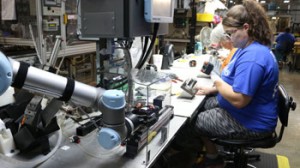 A mobile fleet of Universal Robots will now receive daily work orders to solve ever-changing tasks with high mix/low volume electronics manufacturer Scott Fetzer Electrical Group (SFEG). The collaborative robots have optimised production by 20%, taking over monotonous and potentially hazardous tasks from employees now reallocated to more rewarding jobs.
A mobile fleet of Universal Robots will now receive daily work orders to solve ever-changing tasks with high mix/low volume electronics manufacturer Scott Fetzer Electrical Group (SFEG). The collaborative robots have optimised production by 20%, taking over monotonous and potentially hazardous tasks from employees now reallocated to more rewarding jobs.
The fact that Universal Robots are re-deployable and can operate with no safety guarding right next to humans is a radical break away from traditional industrial robot that usually stay hardwired behind safety guarding, fenced off from people. The interactive design makes it easy to set them up for a new task while the built-in safety system enables the robot arm to automatically stop operating if it encounters objects or people in its path.
Matthew Bush, director of operations at SFEG, came across this new automation solution as he was looking for ways to make SFEG more competitive on the global scale, while taking more advantage of existing machinery. “One of our biggest challenges is we’re a high mix/low volume producer, most of our lines don’t run all the time, so trying to find a way to put robots on the line in the traditional sense was a very big challenge.
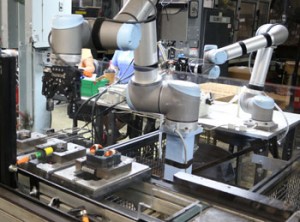 “We wanted to build a mobile, flexible robot force. The only way we would accomplish this was with a collaborative robot. We only saw a couple of offerings and the UR robot was the only robot that we thought could do the job. It’s got the speed and precision of a standard industrial robot with the ability to move around and work next to humans.”
“We wanted to build a mobile, flexible robot force. The only way we would accomplish this was with a collaborative robot. We only saw a couple of offerings and the UR robot was the only robot that we thought could do the job. It’s got the speed and precision of a standard industrial robot with the ability to move around and work next to humans.”
SFEG placed the UR robots on pedestals with wheels and is now building the fleet of mobile UR robots deployed throughout the sheet metal department, integrating them in the entire production cycle from cutting the initial blank on the blanking press to forming, folding and final assembly of the electrical components. Additional robots are planned to help tend the turret presses and press brakes.
“We want to have robots standing by, waiting for a job to do. When the staff arrive in the morning, we’ll have work-orders printed for employees to wheel the robots over to the tasks at hand that day.”
Productivity increased by 20%
General manager at SFEG, Rob Goldiez explains how productivity and consistency on lines with UR robots improved: “Before we had the Universal Robots on our transformer line, we averaged about 10 parts per person per hour. That’s up to 12 parts per person per hour now, so about a 20% increase from having the Universal Robots working hand in hand with our people.”
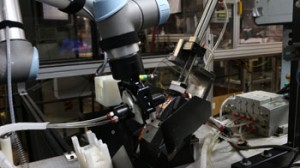 The UR robots working the motor field line are a UR5 and a UR10 robot named after their payload in kilos. The UR5 is placed at the end of the line right next to an employee that hands the robot a motor field part. The UR5 picks up the part, puts it in a holder, picks up a wire cutter to trim the wires, and then places the part for the UR10 robot to pick up and place on a conveyor for final assembly. The two UR robots work in tandem and communicate their position to each other through Modbus socket connections.
The UR robots working the motor field line are a UR5 and a UR10 robot named after their payload in kilos. The UR5 is placed at the end of the line right next to an employee that hands the robot a motor field part. The UR5 picks up the part, puts it in a holder, picks up a wire cutter to trim the wires, and then places the part for the UR10 robot to pick up and place on a conveyor for final assembly. The two UR robots work in tandem and communicate their position to each other through Modbus socket connections.
“We can interlock multiple robots together and read through Modbus the TCP connections and robot status,” says SFEG principal engineer Jamie Cook. “We can also pass information along to other software packages, and collect data. It opens up a lot of doors to do a lot of things we’re just now beginning to look at.”
Implementation time reduced up to 50%
Having not programmed cage-free robots before, Cook was somewhat anxious before the UR robots arrived. But UR robot comes with a touch screen pendant that all programming is done through. Directing the robot arm can be done either through arrow keys on the screen, or by simply grabbing the robot arm and ‘teaching’ it the desired moves between waypoints. That eliminated the structured text programming Cook usually had to code when working with traditional robots.
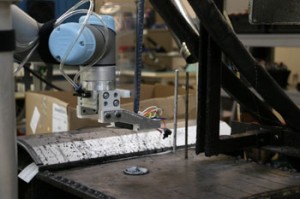 “It was really easy to learn and it went much smoother than I anticipated,” he says. “I did it with minimal training just looking through the operator manual and following the intuitive user interface. I would say it took a third to half of the implementation time out of it based on previous experiences I’ve had.”
“It was really easy to learn and it went much smoother than I anticipated,” he says. “I did it with minimal training just looking through the operator manual and following the intuitive user interface. I would say it took a third to half of the implementation time out of it based on previous experiences I’ve had.”
One of the new applications now using the UR robots for data collection is in the live testing of new designs, where the small motor manufactured at SFEG is placed in the customer product. “We then use one of our mobile robots to turn the product’s switch on and off, running it for a minute on, 30 seconds off, for the next 400 hours,” says Matt Bush. “It’s a quick way for us to perform life cycle testing. We didn’t have to set up a lot of equipment; the initial program took us only about five minutes to create.”
I was surprised how simple it was. If you can work a smart phone, you can pretty much work these robots
The robot collects data pertinent to the test such as maximum amperage, average amperage and the number of cycles completed and transmits that data to a data storage. “It’s enabled us to actually engage our customer in the testing as well; they’re excited to see us use new technology to push our design faster into production. It gives us an advantage over our competitors thousands of miles away in low-cost source countries. We’re now winning orders against Chinese competitors and bringing back work that used to be sourced in China as well.”
As SFEG looked for tasks to automate, eliminating monotonous and potentially dangerous tasks was the number one priority. Another task now handled by the mobile UR robot fleet is filling epoxy into circuit boards. “In the past, employees would make up a big batch of circuit boards and they would stand there and manually fill them with two-part epoxy and send them down the curing line,” says Bush. “Today, the robot does that all day long enabling us to go to a one-piece flow.
“This is an example of an application that would not happen with a stationary robot as we have to move the robot in and out of the cell every day to dismantle the epoxy machine and clean up the cell,” says the operations director, who also emphasises the safety hazards now avoided on the motor field line by having a UR robot handle the wire cutting. “It’s a potential carpal tunnel syndrome application cutting about 16,000 wires a day by hand. So we thought that was a great place to put robots.”
Sebrina Thompson, line lead at SFEG, comments: “When the robots first came out on the floor, employees were very anxious as they thought they would be replaced. But the robots handle a lot of tedious tasks for us now, enabling us to focus on more challenging jobs. My colleagues are constantly trying to find out where we can put the next robots. I was surprised how simple it was. If you can work a smart phone, you can pretty much work these robots.”
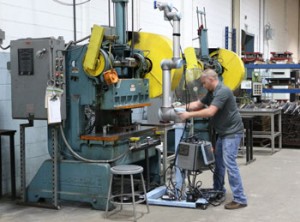 SFEG has reallocated employees that used to handle tasks taken over by robots to other production areas where the company has seen growth or to fill holes due to natural attrition. “We’re seeing about one-to-one movement of people from where we put in a robot, allowing us to move a person to another area of the business,” says general manager Rob Goldiez. “We have 14 robots from Universal Robots right now and as we have all those implemented, we expect to be able reposition 14 employees. It has allowed us to be much more flexible as a manufacturer.”
SFEG has reallocated employees that used to handle tasks taken over by robots to other production areas where the company has seen growth or to fill holes due to natural attrition. “We’re seeing about one-to-one movement of people from where we put in a robot, allowing us to move a person to another area of the business,” says general manager Rob Goldiez. “We have 14 robots from Universal Robots right now and as we have all those implemented, we expect to be able reposition 14 employees. It has allowed us to be much more flexible as a manufacturer.”
Focusing on the next robotic tasks
One of the next robot tasks currently being developed at SFEG is putting c-clips on armatures. At the varnish oven, two UR10s will be loading and unloading baskets with motors. One UR10 is already deployed at the end of the varnish conveyor, working as a simple transfer station, moving baskets between lines.
“The reason we chose to use a UR10 there wasn’t because it was the most effective way to do it,” says Bush. “We had an extra UR10 sitting idle; it was very simple to integrate, and it gave us the ability to completely control the conveyor line throughout the day. It saved us money as we didn’t have to go out and spend another nine to twelve thousand dollars on another transfer station.”
With SFEG currently experiencing a payback period between 12 and 14 months on the UR robots, Bush adds: “We’re looking at everything we’re designing now new to make sure we can assemble it with a robot. If we can’t put that together with a robot, we’ve got to go back to the drawing board and try again.”
Visit the Universal Robots website for more information.
See all stories for Universal Robots
















